Strategic Human Resource Management: A Report on Tesco Plc's Practices
VerifiedAdded on 2020/10/05
|11
|2580
|241
Report
AI Summary
This report provides a comprehensive analysis of strategic human resource management (SHRM) within Tesco Plc, a major multinational retailer. It begins with an introduction to SHRM, emphasizing its integration with organizational strategy. The main body delves into Tesco's HR policies and practices, examining areas such as regulatory policies, paid time off, and pre-employment practices. Theoretical concepts like High Commitment HRM and Hard and Soft HRM models are also explored, providing a deeper understanding of different approaches. The report further investigates external forces impacting Tesco's SHRM decisions, including employment market dynamics, skill shortages, political and economic factors, technological advancements, and government compliance. Finally, the report analyzes the organization of the HR function, highlighting the Ulrich Model and its four key roles: HR business partner, change agent, administration expert, and employee advocate. Challenges faced by line managers are also discussed. This report offers valuable insights into the practical application of SHRM principles within a real-world business context.
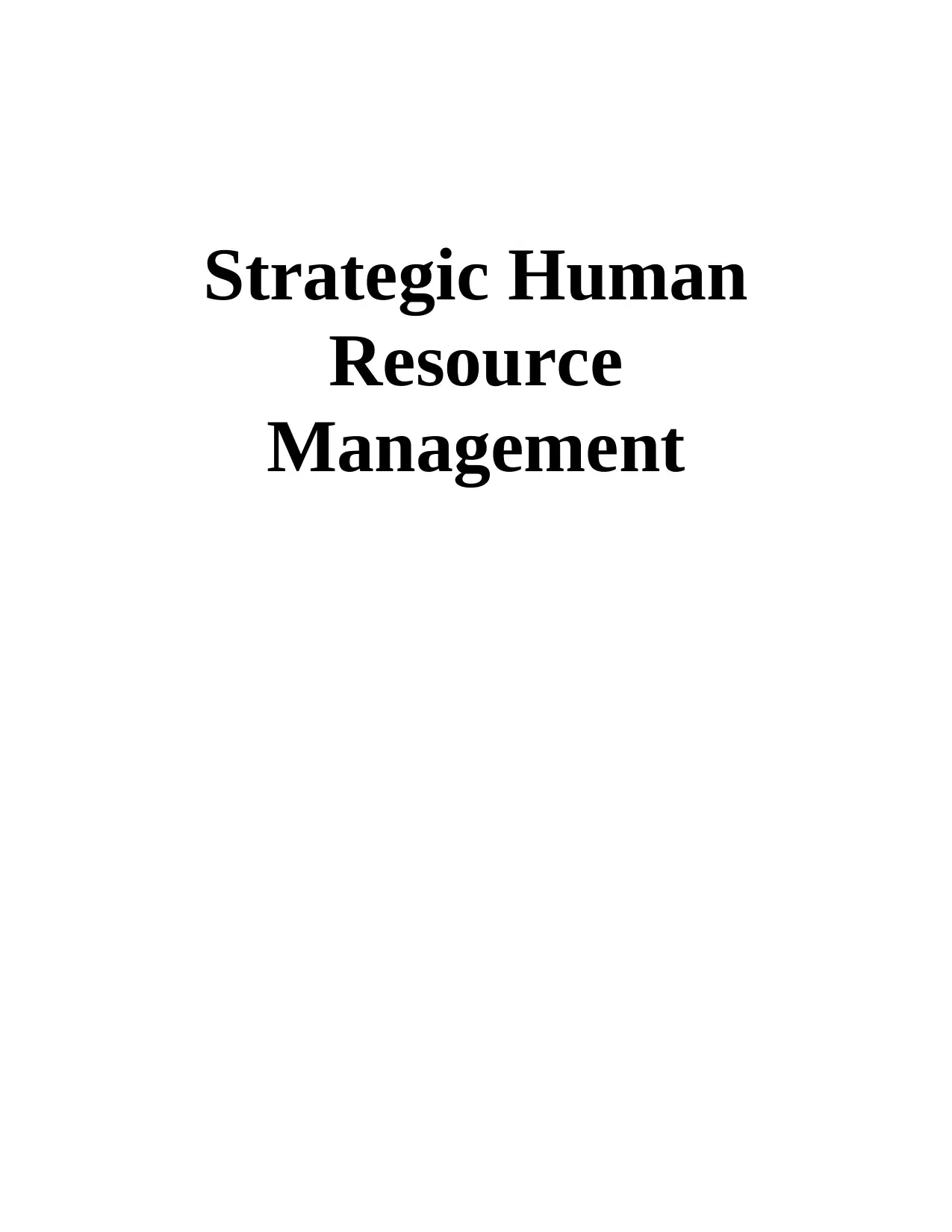
Strategic Human
Resource
Management
Resource
Management
Paraphrase This Document
Need a fresh take? Get an instant paraphrase of this document with our AI Paraphraser
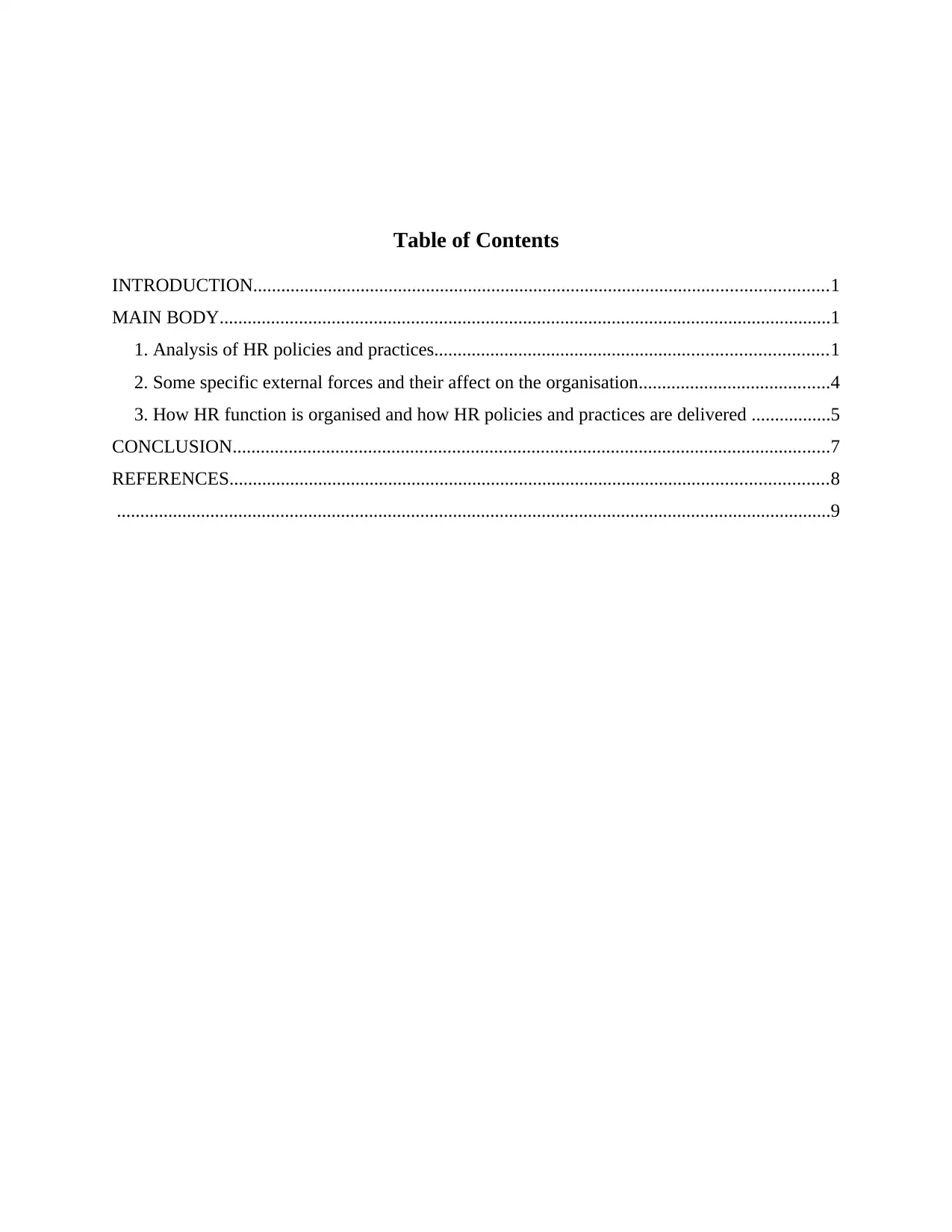
Table of Contents
INTRODUCTION...........................................................................................................................1
MAIN BODY...................................................................................................................................1
1. Analysis of HR policies and practices....................................................................................1
2. Some specific external forces and their affect on the organisation.........................................4
3. How HR function is organised and how HR policies and practices are delivered .................5
CONCLUSION................................................................................................................................7
REFERENCES................................................................................................................................8
.........................................................................................................................................................9
INTRODUCTION...........................................................................................................................1
MAIN BODY...................................................................................................................................1
1. Analysis of HR policies and practices....................................................................................1
2. Some specific external forces and their affect on the organisation.........................................4
3. How HR function is organised and how HR policies and practices are delivered .................5
CONCLUSION................................................................................................................................7
REFERENCES................................................................................................................................8
.........................................................................................................................................................9
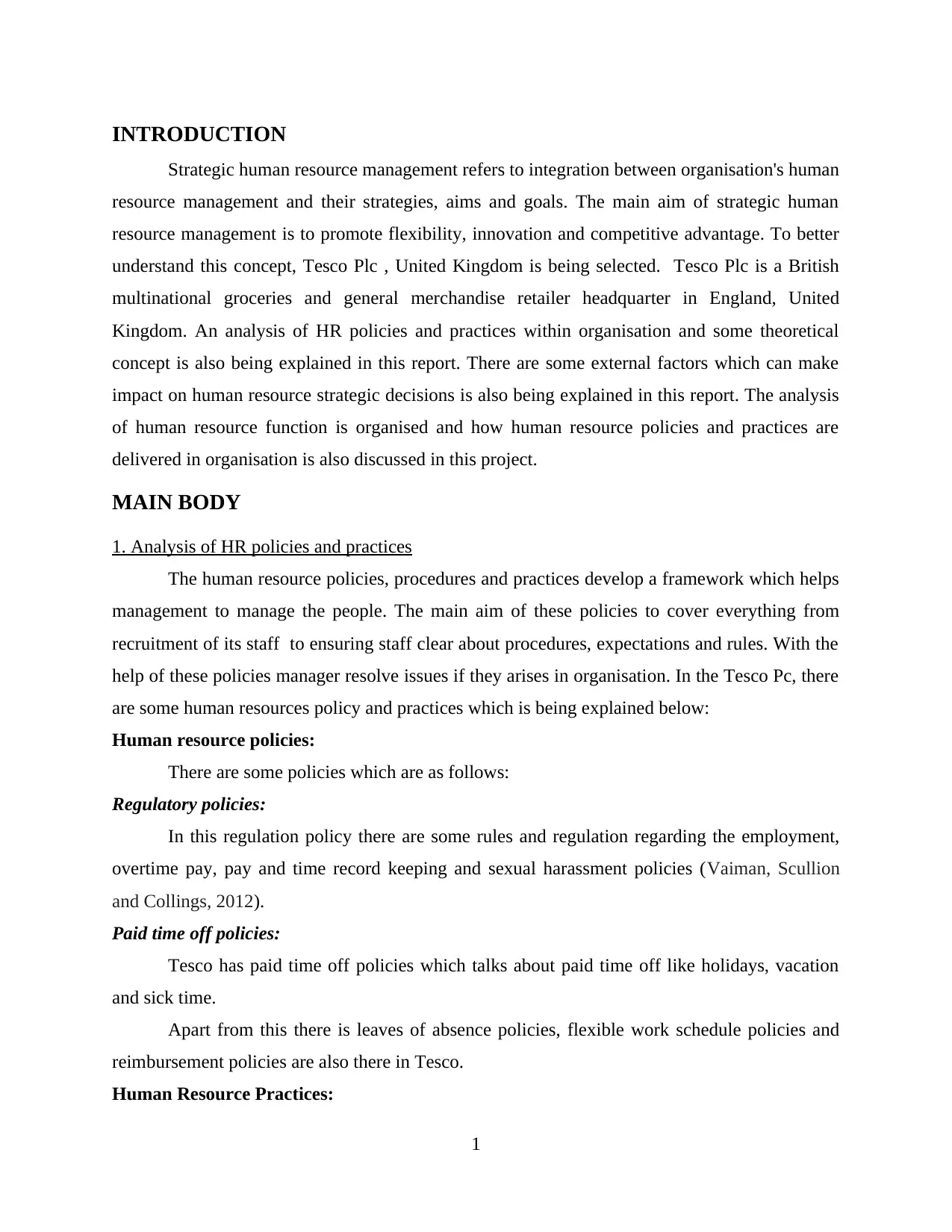
INTRODUCTION
Strategic human resource management refers to integration between organisation's human
resource management and their strategies, aims and goals. The main aim of strategic human
resource management is to promote flexibility, innovation and competitive advantage. To better
understand this concept, Tesco Plc , United Kingdom is being selected. Tesco Plc is a British
multinational groceries and general merchandise retailer headquarter in England, United
Kingdom. An analysis of HR policies and practices within organisation and some theoretical
concept is also being explained in this report. There are some external factors which can make
impact on human resource strategic decisions is also being explained in this report. The analysis
of human resource function is organised and how human resource policies and practices are
delivered in organisation is also discussed in this project.
MAIN BODY
1. Analysis of HR policies and practices
The human resource policies, procedures and practices develop a framework which helps
management to manage the people. The main aim of these policies to cover everything from
recruitment of its staff to ensuring staff clear about procedures, expectations and rules. With the
help of these policies manager resolve issues if they arises in organisation. In the Tesco Pc, there
are some human resources policy and practices which is being explained below:
Human resource policies:
There are some policies which are as follows:
Regulatory policies:
In this regulation policy there are some rules and regulation regarding the employment,
overtime pay, pay and time record keeping and sexual harassment policies (Vaiman, Scullion
and Collings, 2012).
Paid time off policies:
Tesco has paid time off policies which talks about paid time off like holidays, vacation
and sick time.
Apart from this there is leaves of absence policies, flexible work schedule policies and
reimbursement policies are also there in Tesco.
Human Resource Practices:
1
Strategic human resource management refers to integration between organisation's human
resource management and their strategies, aims and goals. The main aim of strategic human
resource management is to promote flexibility, innovation and competitive advantage. To better
understand this concept, Tesco Plc , United Kingdom is being selected. Tesco Plc is a British
multinational groceries and general merchandise retailer headquarter in England, United
Kingdom. An analysis of HR policies and practices within organisation and some theoretical
concept is also being explained in this report. There are some external factors which can make
impact on human resource strategic decisions is also being explained in this report. The analysis
of human resource function is organised and how human resource policies and practices are
delivered in organisation is also discussed in this project.
MAIN BODY
1. Analysis of HR policies and practices
The human resource policies, procedures and practices develop a framework which helps
management to manage the people. The main aim of these policies to cover everything from
recruitment of its staff to ensuring staff clear about procedures, expectations and rules. With the
help of these policies manager resolve issues if they arises in organisation. In the Tesco Pc, there
are some human resources policy and practices which is being explained below:
Human resource policies:
There are some policies which are as follows:
Regulatory policies:
In this regulation policy there are some rules and regulation regarding the employment,
overtime pay, pay and time record keeping and sexual harassment policies (Vaiman, Scullion
and Collings, 2012).
Paid time off policies:
Tesco has paid time off policies which talks about paid time off like holidays, vacation
and sick time.
Apart from this there is leaves of absence policies, flexible work schedule policies and
reimbursement policies are also there in Tesco.
Human Resource Practices:
1
⊘ This is a preview!⊘
Do you want full access?
Subscribe today to unlock all pages.

Trusted by 1+ million students worldwide
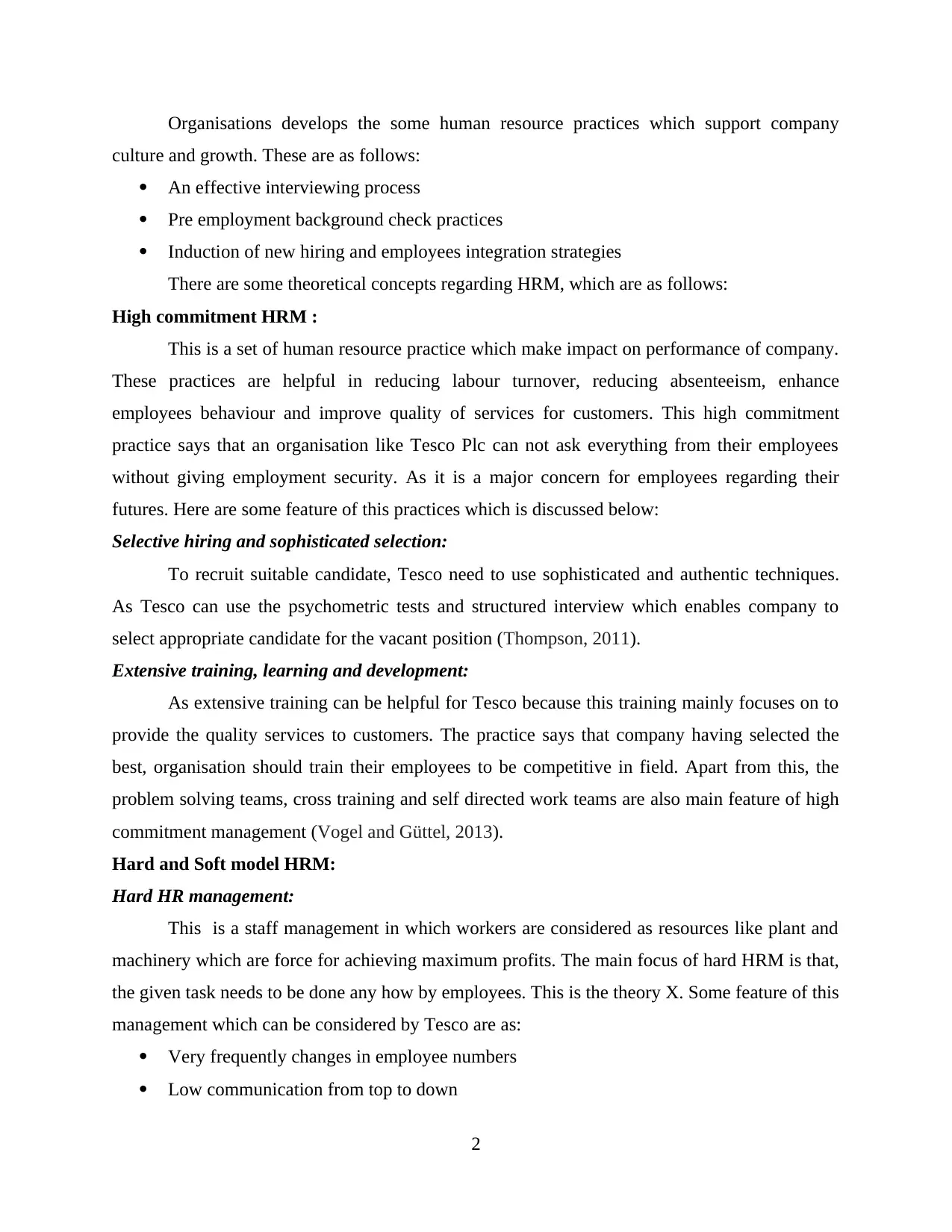
Organisations develops the some human resource practices which support company
culture and growth. These are as follows:
An effective interviewing process
Pre employment background check practices
Induction of new hiring and employees integration strategies
There are some theoretical concepts regarding HRM, which are as follows:
High commitment HRM :
This is a set of human resource practice which make impact on performance of company.
These practices are helpful in reducing labour turnover, reducing absenteeism, enhance
employees behaviour and improve quality of services for customers. This high commitment
practice says that an organisation like Tesco Plc can not ask everything from their employees
without giving employment security. As it is a major concern for employees regarding their
futures. Here are some feature of this practices which is discussed below:
Selective hiring and sophisticated selection:
To recruit suitable candidate, Tesco need to use sophisticated and authentic techniques.
As Tesco can use the psychometric tests and structured interview which enables company to
select appropriate candidate for the vacant position (Thompson, 2011).
Extensive training, learning and development:
As extensive training can be helpful for Tesco because this training mainly focuses on to
provide the quality services to customers. The practice says that company having selected the
best, organisation should train their employees to be competitive in field. Apart from this, the
problem solving teams, cross training and self directed work teams are also main feature of high
commitment management (Vogel and Güttel, 2013).
Hard and Soft model HRM:
Hard HR management:
This is a staff management in which workers are considered as resources like plant and
machinery which are force for achieving maximum profits. The main focus of hard HRM is that,
the given task needs to be done any how by employees. This is the theory X. Some feature of this
management which can be considered by Tesco are as:
Very frequently changes in employee numbers
Low communication from top to down
2
culture and growth. These are as follows:
An effective interviewing process
Pre employment background check practices
Induction of new hiring and employees integration strategies
There are some theoretical concepts regarding HRM, which are as follows:
High commitment HRM :
This is a set of human resource practice which make impact on performance of company.
These practices are helpful in reducing labour turnover, reducing absenteeism, enhance
employees behaviour and improve quality of services for customers. This high commitment
practice says that an organisation like Tesco Plc can not ask everything from their employees
without giving employment security. As it is a major concern for employees regarding their
futures. Here are some feature of this practices which is discussed below:
Selective hiring and sophisticated selection:
To recruit suitable candidate, Tesco need to use sophisticated and authentic techniques.
As Tesco can use the psychometric tests and structured interview which enables company to
select appropriate candidate for the vacant position (Thompson, 2011).
Extensive training, learning and development:
As extensive training can be helpful for Tesco because this training mainly focuses on to
provide the quality services to customers. The practice says that company having selected the
best, organisation should train their employees to be competitive in field. Apart from this, the
problem solving teams, cross training and self directed work teams are also main feature of high
commitment management (Vogel and Güttel, 2013).
Hard and Soft model HRM:
Hard HR management:
This is a staff management in which workers are considered as resources like plant and
machinery which are force for achieving maximum profits. The main focus of hard HRM is that,
the given task needs to be done any how by employees. This is the theory X. Some feature of this
management which can be considered by Tesco are as:
Very frequently changes in employee numbers
Low communication from top to down
2
Paraphrase This Document
Need a fresh take? Get an instant paraphrase of this document with our AI Paraphraser
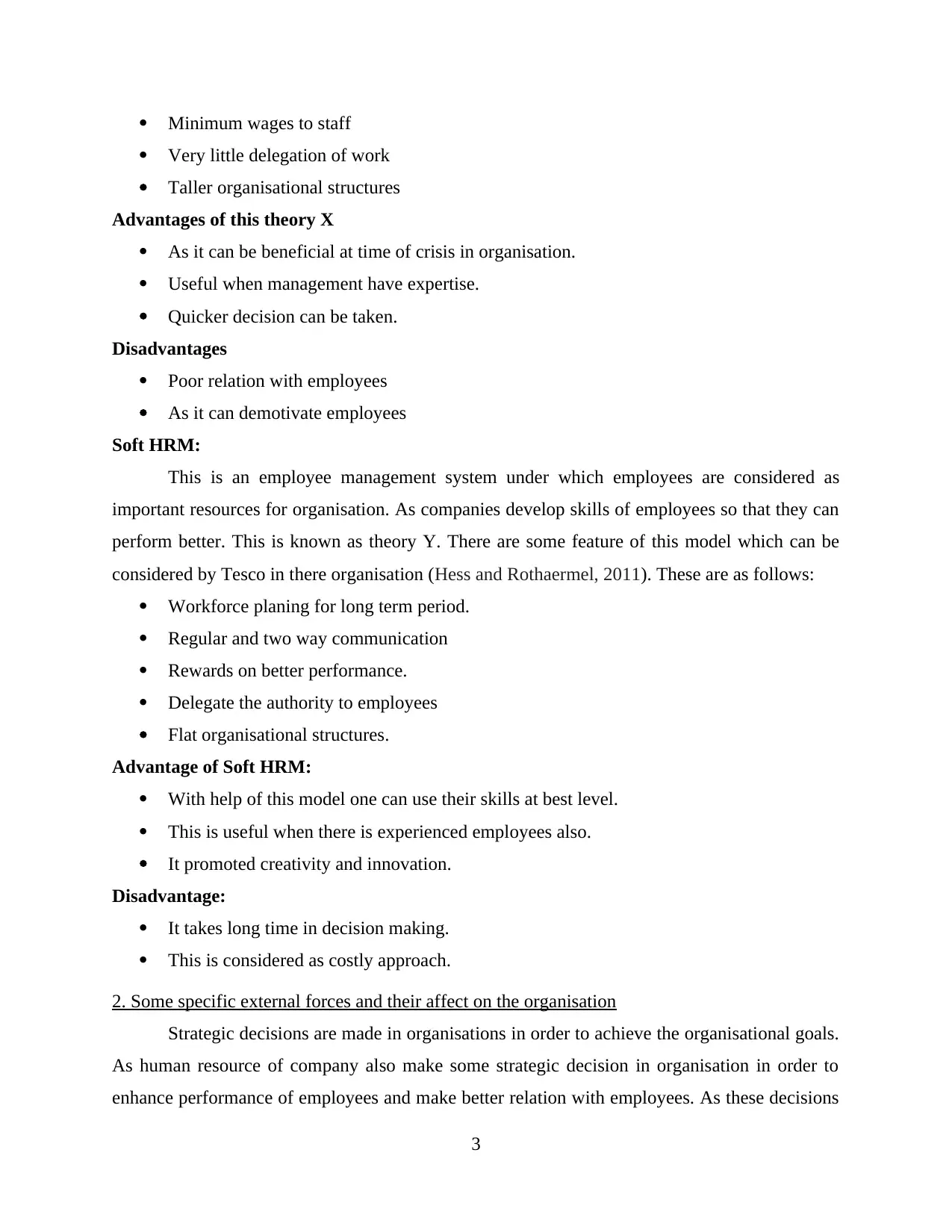
Minimum wages to staff
Very little delegation of work
Taller organisational structures
Advantages of this theory X
As it can be beneficial at time of crisis in organisation.
Useful when management have expertise.
Quicker decision can be taken.
Disadvantages
Poor relation with employees
As it can demotivate employees
Soft HRM:
This is an employee management system under which employees are considered as
important resources for organisation. As companies develop skills of employees so that they can
perform better. This is known as theory Y. There are some feature of this model which can be
considered by Tesco in there organisation (Hess and Rothaermel, 2011). These are as follows:
Workforce planing for long term period.
Regular and two way communication
Rewards on better performance.
Delegate the authority to employees
Flat organisational structures.
Advantage of Soft HRM:
With help of this model one can use their skills at best level.
This is useful when there is experienced employees also.
It promoted creativity and innovation.
Disadvantage:
It takes long time in decision making.
This is considered as costly approach.
2. Some specific external forces and their affect on the organisation
Strategic decisions are made in organisations in order to achieve the organisational goals.
As human resource of company also make some strategic decision in organisation in order to
enhance performance of employees and make better relation with employees. As these decisions
3
Very little delegation of work
Taller organisational structures
Advantages of this theory X
As it can be beneficial at time of crisis in organisation.
Useful when management have expertise.
Quicker decision can be taken.
Disadvantages
Poor relation with employees
As it can demotivate employees
Soft HRM:
This is an employee management system under which employees are considered as
important resources for organisation. As companies develop skills of employees so that they can
perform better. This is known as theory Y. There are some feature of this model which can be
considered by Tesco in there organisation (Hess and Rothaermel, 2011). These are as follows:
Workforce planing for long term period.
Regular and two way communication
Rewards on better performance.
Delegate the authority to employees
Flat organisational structures.
Advantage of Soft HRM:
With help of this model one can use their skills at best level.
This is useful when there is experienced employees also.
It promoted creativity and innovation.
Disadvantage:
It takes long time in decision making.
This is considered as costly approach.
2. Some specific external forces and their affect on the organisation
Strategic decisions are made in organisations in order to achieve the organisational goals.
As human resource of company also make some strategic decision in organisation in order to
enhance performance of employees and make better relation with employees. As these decisions
3
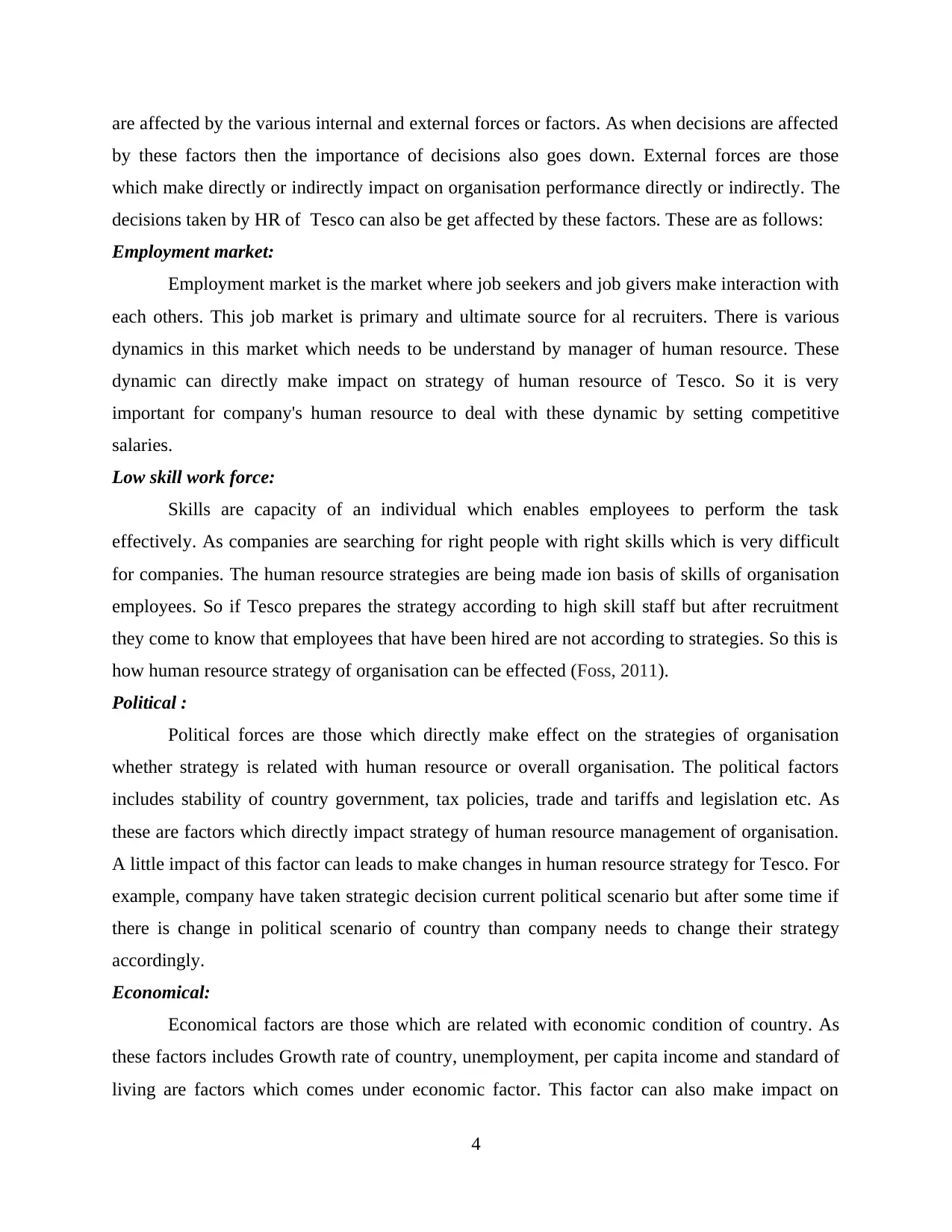
are affected by the various internal and external forces or factors. As when decisions are affected
by these factors then the importance of decisions also goes down. External forces are those
which make directly or indirectly impact on organisation performance directly or indirectly. The
decisions taken by HR of Tesco can also be get affected by these factors. These are as follows:
Employment market:
Employment market is the market where job seekers and job givers make interaction with
each others. This job market is primary and ultimate source for al recruiters. There is various
dynamics in this market which needs to be understand by manager of human resource. These
dynamic can directly make impact on strategy of human resource of Tesco. So it is very
important for company's human resource to deal with these dynamic by setting competitive
salaries.
Low skill work force:
Skills are capacity of an individual which enables employees to perform the task
effectively. As companies are searching for right people with right skills which is very difficult
for companies. The human resource strategies are being made ion basis of skills of organisation
employees. So if Tesco prepares the strategy according to high skill staff but after recruitment
they come to know that employees that have been hired are not according to strategies. So this is
how human resource strategy of organisation can be effected (Foss, 2011).
Political :
Political forces are those which directly make effect on the strategies of organisation
whether strategy is related with human resource or overall organisation. The political factors
includes stability of country government, tax policies, trade and tariffs and legislation etc. As
these are factors which directly impact strategy of human resource management of organisation.
A little impact of this factor can leads to make changes in human resource strategy for Tesco. For
example, company have taken strategic decision current political scenario but after some time if
there is change in political scenario of country than company needs to change their strategy
accordingly.
Economical:
Economical factors are those which are related with economic condition of country. As
these factors includes Growth rate of country, unemployment, per capita income and standard of
living are factors which comes under economic factor. This factor can also make impact on
4
by these factors then the importance of decisions also goes down. External forces are those
which make directly or indirectly impact on organisation performance directly or indirectly. The
decisions taken by HR of Tesco can also be get affected by these factors. These are as follows:
Employment market:
Employment market is the market where job seekers and job givers make interaction with
each others. This job market is primary and ultimate source for al recruiters. There is various
dynamics in this market which needs to be understand by manager of human resource. These
dynamic can directly make impact on strategy of human resource of Tesco. So it is very
important for company's human resource to deal with these dynamic by setting competitive
salaries.
Low skill work force:
Skills are capacity of an individual which enables employees to perform the task
effectively. As companies are searching for right people with right skills which is very difficult
for companies. The human resource strategies are being made ion basis of skills of organisation
employees. So if Tesco prepares the strategy according to high skill staff but after recruitment
they come to know that employees that have been hired are not according to strategies. So this is
how human resource strategy of organisation can be effected (Foss, 2011).
Political :
Political forces are those which directly make effect on the strategies of organisation
whether strategy is related with human resource or overall organisation. The political factors
includes stability of country government, tax policies, trade and tariffs and legislation etc. As
these are factors which directly impact strategy of human resource management of organisation.
A little impact of this factor can leads to make changes in human resource strategy for Tesco. For
example, company have taken strategic decision current political scenario but after some time if
there is change in political scenario of country than company needs to change their strategy
accordingly.
Economical:
Economical factors are those which are related with economic condition of country. As
these factors includes Growth rate of country, unemployment, per capita income and standard of
living are factors which comes under economic factor. This factor can also make impact on
4
⊘ This is a preview!⊘
Do you want full access?
Subscribe today to unlock all pages.

Trusted by 1+ million students worldwide
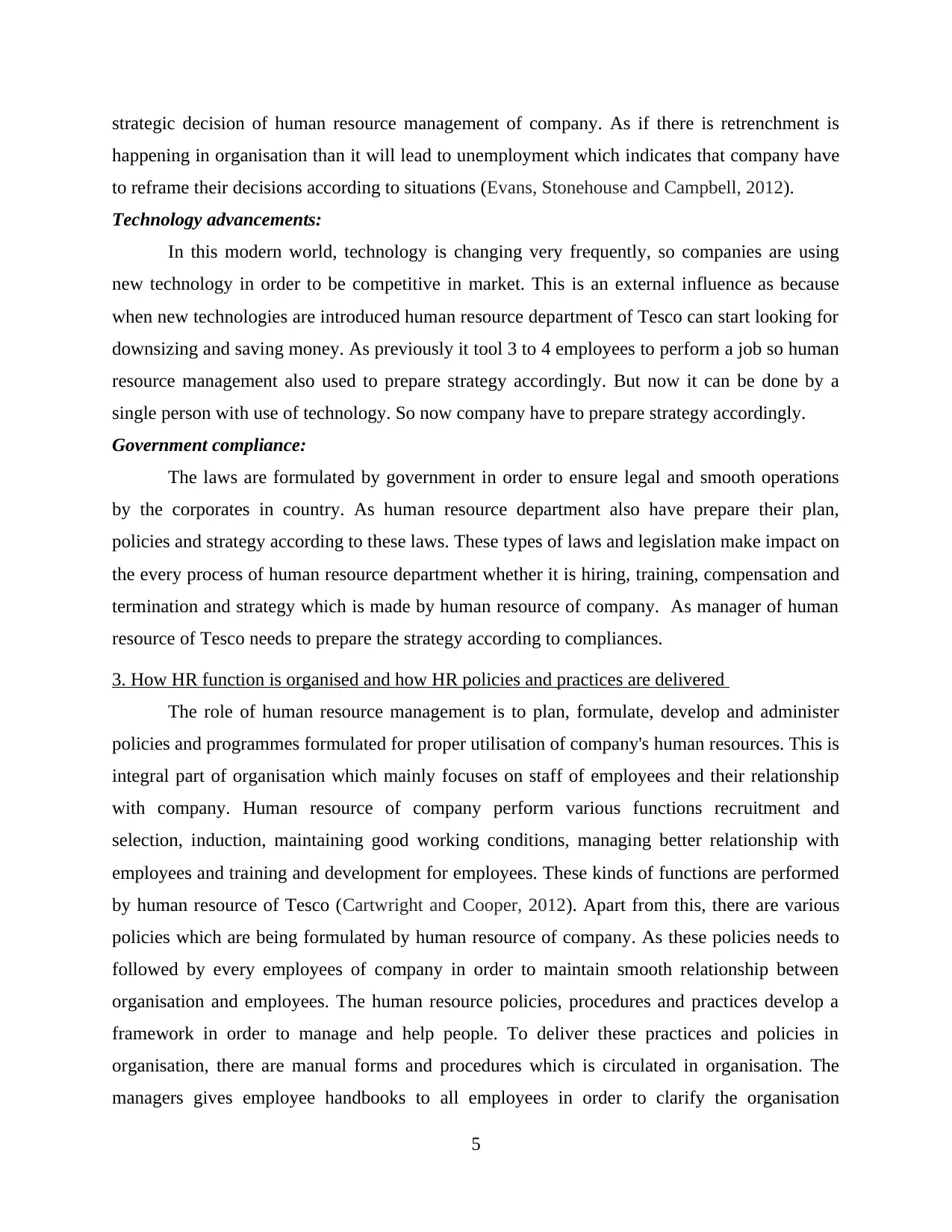
strategic decision of human resource management of company. As if there is retrenchment is
happening in organisation than it will lead to unemployment which indicates that company have
to reframe their decisions according to situations (Evans, Stonehouse and Campbell, 2012).
Technology advancements:
In this modern world, technology is changing very frequently, so companies are using
new technology in order to be competitive in market. This is an external influence as because
when new technologies are introduced human resource department of Tesco can start looking for
downsizing and saving money. As previously it tool 3 to 4 employees to perform a job so human
resource management also used to prepare strategy accordingly. But now it can be done by a
single person with use of technology. So now company have to prepare strategy accordingly.
Government compliance:
The laws are formulated by government in order to ensure legal and smooth operations
by the corporates in country. As human resource department also have prepare their plan,
policies and strategy according to these laws. These types of laws and legislation make impact on
the every process of human resource department whether it is hiring, training, compensation and
termination and strategy which is made by human resource of company. As manager of human
resource of Tesco needs to prepare the strategy according to compliances.
3. How HR function is organised and how HR policies and practices are delivered
The role of human resource management is to plan, formulate, develop and administer
policies and programmes formulated for proper utilisation of company's human resources. This is
integral part of organisation which mainly focuses on staff of employees and their relationship
with company. Human resource of company perform various functions recruitment and
selection, induction, maintaining good working conditions, managing better relationship with
employees and training and development for employees. These kinds of functions are performed
by human resource of Tesco (Cartwright and Cooper, 2012). Apart from this, there are various
policies which are being formulated by human resource of company. As these policies needs to
followed by every employees of company in order to maintain smooth relationship between
organisation and employees. The human resource policies, procedures and practices develop a
framework in order to manage and help people. To deliver these practices and policies in
organisation, there are manual forms and procedures which is circulated in organisation. The
managers gives employee handbooks to all employees in order to clarify the organisation
5
happening in organisation than it will lead to unemployment which indicates that company have
to reframe their decisions according to situations (Evans, Stonehouse and Campbell, 2012).
Technology advancements:
In this modern world, technology is changing very frequently, so companies are using
new technology in order to be competitive in market. This is an external influence as because
when new technologies are introduced human resource department of Tesco can start looking for
downsizing and saving money. As previously it tool 3 to 4 employees to perform a job so human
resource management also used to prepare strategy accordingly. But now it can be done by a
single person with use of technology. So now company have to prepare strategy accordingly.
Government compliance:
The laws are formulated by government in order to ensure legal and smooth operations
by the corporates in country. As human resource department also have prepare their plan,
policies and strategy according to these laws. These types of laws and legislation make impact on
the every process of human resource department whether it is hiring, training, compensation and
termination and strategy which is made by human resource of company. As manager of human
resource of Tesco needs to prepare the strategy according to compliances.
3. How HR function is organised and how HR policies and practices are delivered
The role of human resource management is to plan, formulate, develop and administer
policies and programmes formulated for proper utilisation of company's human resources. This is
integral part of organisation which mainly focuses on staff of employees and their relationship
with company. Human resource of company perform various functions recruitment and
selection, induction, maintaining good working conditions, managing better relationship with
employees and training and development for employees. These kinds of functions are performed
by human resource of Tesco (Cartwright and Cooper, 2012). Apart from this, there are various
policies which are being formulated by human resource of company. As these policies needs to
followed by every employees of company in order to maintain smooth relationship between
organisation and employees. The human resource policies, procedures and practices develop a
framework in order to manage and help people. To deliver these practices and policies in
organisation, there are manual forms and procedures which is circulated in organisation. The
managers gives employee handbooks to all employees in order to clarify the organisation
5
Paraphrase This Document
Need a fresh take? Get an instant paraphrase of this document with our AI Paraphraser
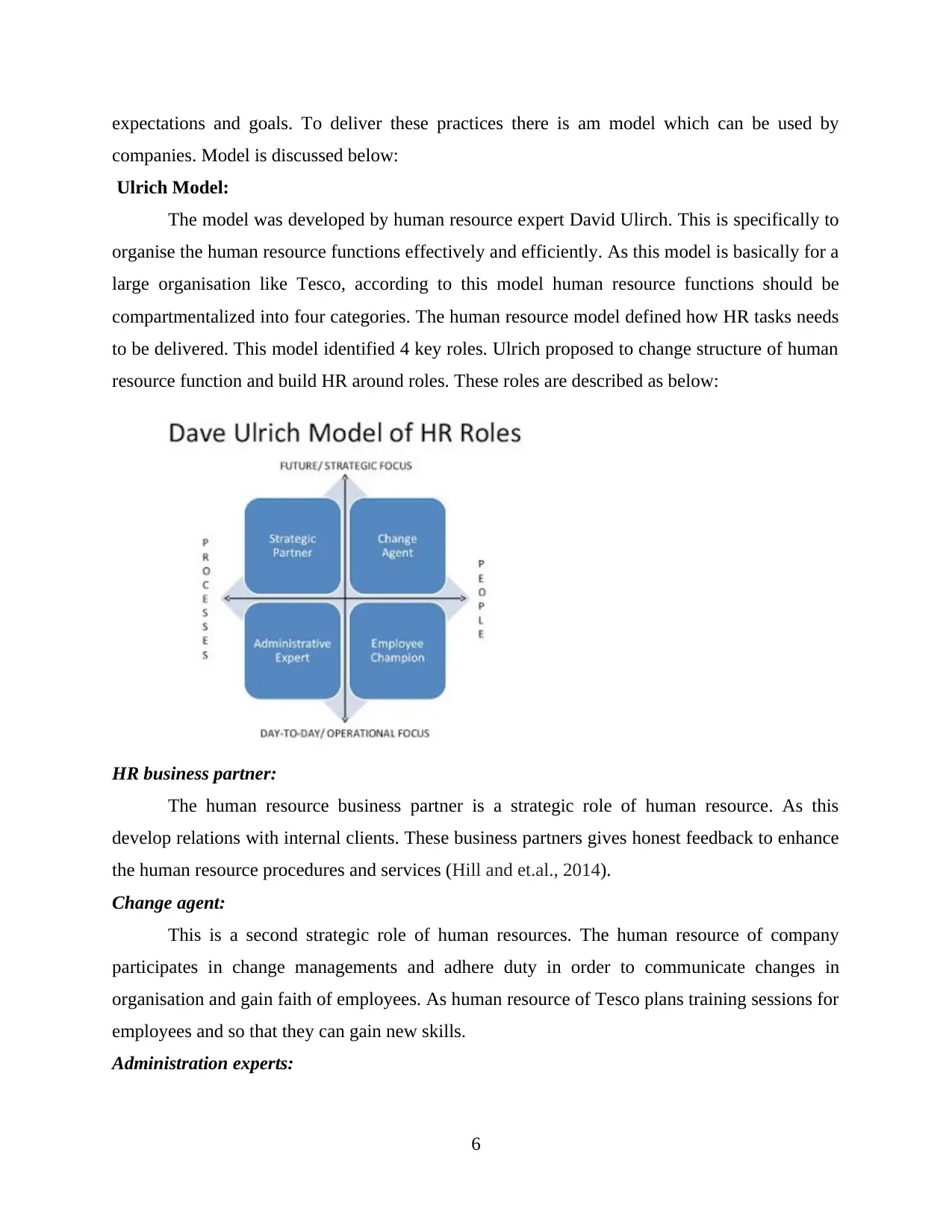
expectations and goals. To deliver these practices there is am model which can be used by
companies. Model is discussed below:
Ulrich Model:
The model was developed by human resource expert David Ulirch. This is specifically to
organise the human resource functions effectively and efficiently. As this model is basically for a
large organisation like Tesco, according to this model human resource functions should be
compartmentalized into four categories. The human resource model defined how HR tasks needs
to be delivered. This model identified 4 key roles. Ulrich proposed to change structure of human
resource function and build HR around roles. These roles are described as below:
HR business partner:
The human resource business partner is a strategic role of human resource. As this
develop relations with internal clients. These business partners gives honest feedback to enhance
the human resource procedures and services (Hill and et.al., 2014).
Change agent:
This is a second strategic role of human resources. The human resource of company
participates in change managements and adhere duty in order to communicate changes in
organisation and gain faith of employees. As human resource of Tesco plans training sessions for
employees and so that they can gain new skills.
Administration experts:
6
companies. Model is discussed below:
Ulrich Model:
The model was developed by human resource expert David Ulirch. This is specifically to
organise the human resource functions effectively and efficiently. As this model is basically for a
large organisation like Tesco, according to this model human resource functions should be
compartmentalized into four categories. The human resource model defined how HR tasks needs
to be delivered. This model identified 4 key roles. Ulrich proposed to change structure of human
resource function and build HR around roles. These roles are described as below:
HR business partner:
The human resource business partner is a strategic role of human resource. As this
develop relations with internal clients. These business partners gives honest feedback to enhance
the human resource procedures and services (Hill and et.al., 2014).
Change agent:
This is a second strategic role of human resources. The human resource of company
participates in change managements and adhere duty in order to communicate changes in
organisation and gain faith of employees. As human resource of Tesco plans training sessions for
employees and so that they can gain new skills.
Administration experts:
6
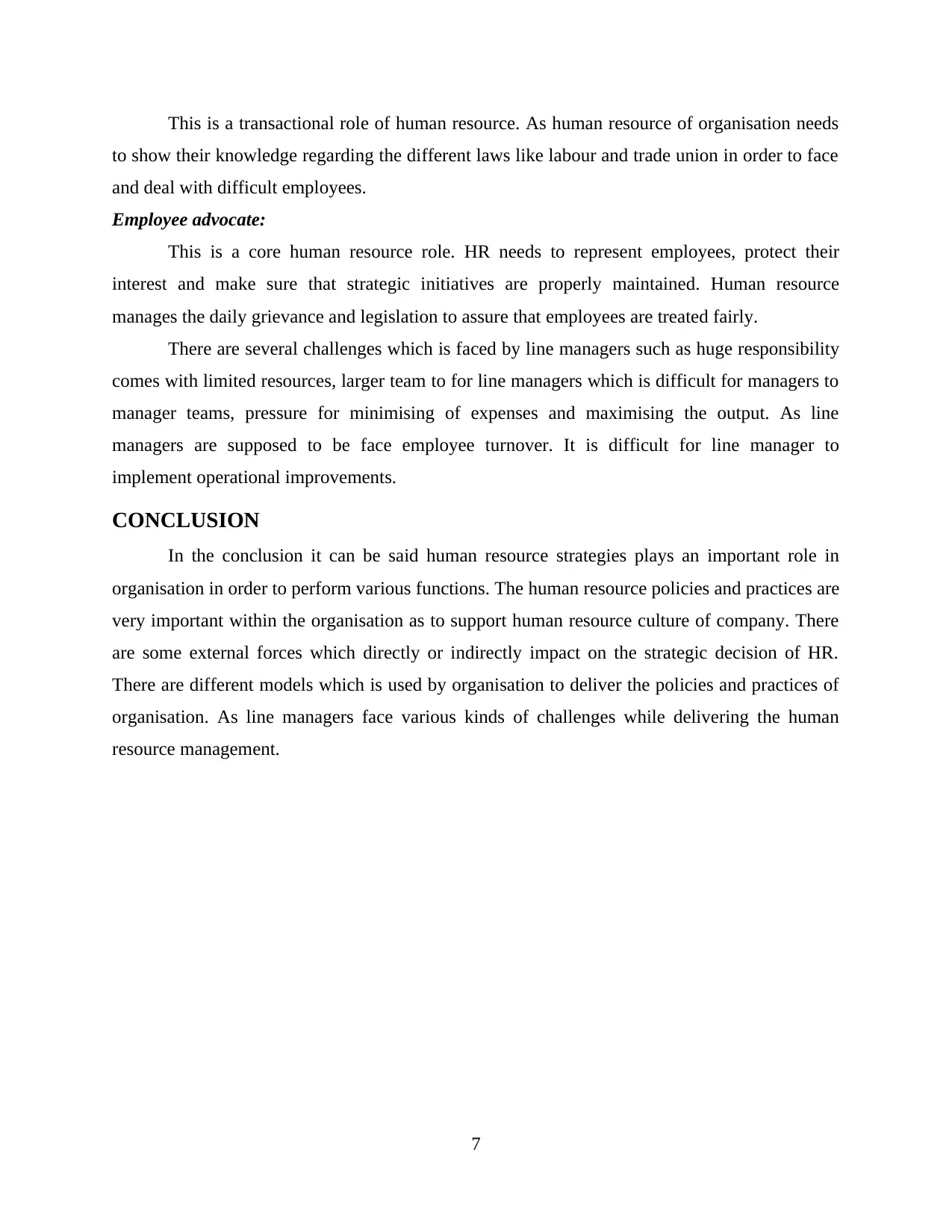
This is a transactional role of human resource. As human resource of organisation needs
to show their knowledge regarding the different laws like labour and trade union in order to face
and deal with difficult employees.
Employee advocate:
This is a core human resource role. HR needs to represent employees, protect their
interest and make sure that strategic initiatives are properly maintained. Human resource
manages the daily grievance and legislation to assure that employees are treated fairly.
There are several challenges which is faced by line managers such as huge responsibility
comes with limited resources, larger team to for line managers which is difficult for managers to
manager teams, pressure for minimising of expenses and maximising the output. As line
managers are supposed to be face employee turnover. It is difficult for line manager to
implement operational improvements.
CONCLUSION
In the conclusion it can be said human resource strategies plays an important role in
organisation in order to perform various functions. The human resource policies and practices are
very important within the organisation as to support human resource culture of company. There
are some external forces which directly or indirectly impact on the strategic decision of HR.
There are different models which is used by organisation to deliver the policies and practices of
organisation. As line managers face various kinds of challenges while delivering the human
resource management.
7
to show their knowledge regarding the different laws like labour and trade union in order to face
and deal with difficult employees.
Employee advocate:
This is a core human resource role. HR needs to represent employees, protect their
interest and make sure that strategic initiatives are properly maintained. Human resource
manages the daily grievance and legislation to assure that employees are treated fairly.
There are several challenges which is faced by line managers such as huge responsibility
comes with limited resources, larger team to for line managers which is difficult for managers to
manager teams, pressure for minimising of expenses and maximising the output. As line
managers are supposed to be face employee turnover. It is difficult for line manager to
implement operational improvements.
CONCLUSION
In the conclusion it can be said human resource strategies plays an important role in
organisation in order to perform various functions. The human resource policies and practices are
very important within the organisation as to support human resource culture of company. There
are some external forces which directly or indirectly impact on the strategic decision of HR.
There are different models which is used by organisation to deliver the policies and practices of
organisation. As line managers face various kinds of challenges while delivering the human
resource management.
7
⊘ This is a preview!⊘
Do you want full access?
Subscribe today to unlock all pages.

Trusted by 1+ million students worldwide
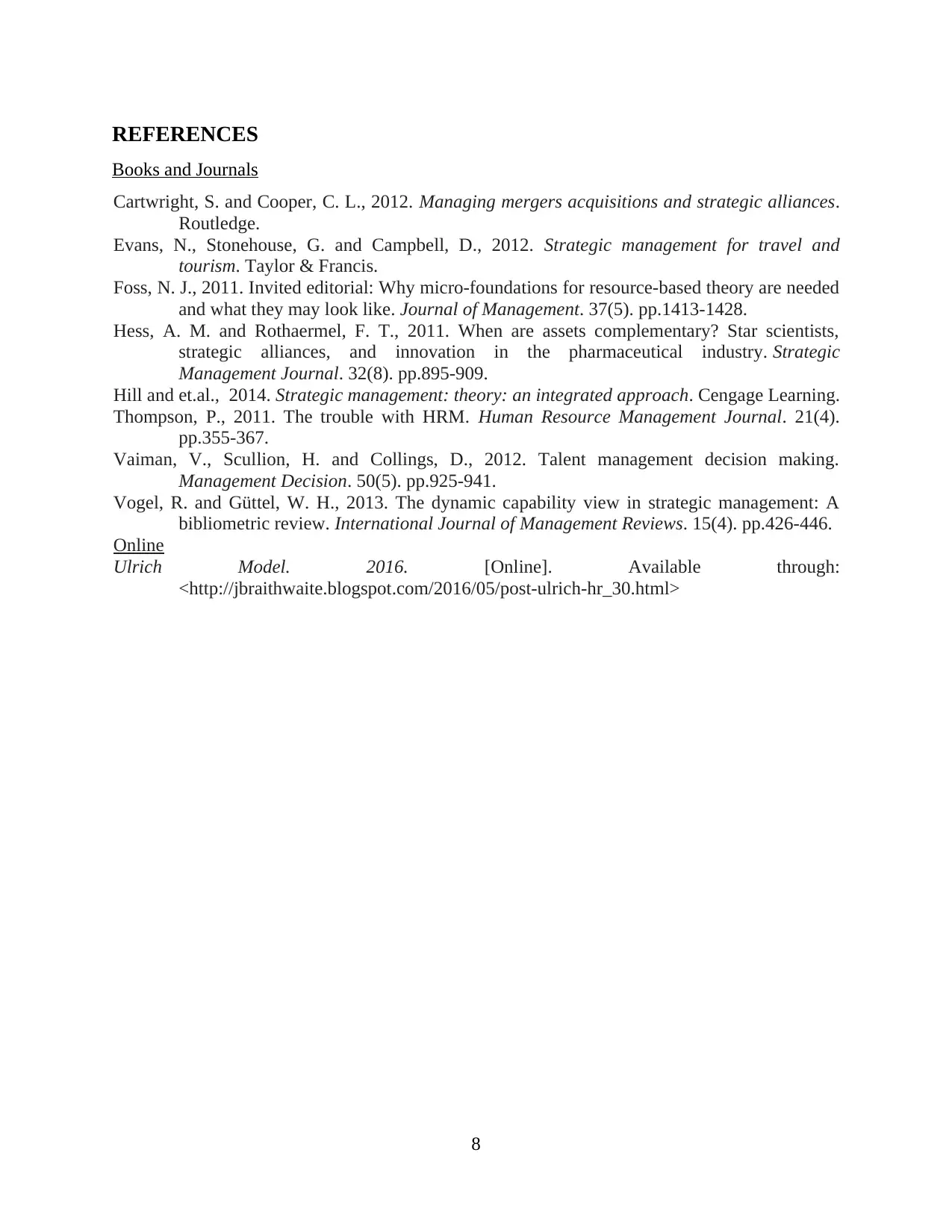
REFERENCES
Books and Journals
Cartwright, S. and Cooper, C. L., 2012. Managing mergers acquisitions and strategic alliances.
Routledge.
Evans, N., Stonehouse, G. and Campbell, D., 2012. Strategic management for travel and
tourism. Taylor & Francis.
Foss, N. J., 2011. Invited editorial: Why micro-foundations for resource-based theory are needed
and what they may look like. Journal of Management. 37(5). pp.1413-1428.
Hess, A. M. and Rothaermel, F. T., 2011. When are assets complementary? Star scientists,
strategic alliances, and innovation in the pharmaceutical industry. Strategic
Management Journal. 32(8). pp.895-909.
Hill and et.al., 2014. Strategic management: theory: an integrated approach. Cengage Learning.
Thompson, P., 2011. The trouble with HRM. Human Resource Management Journal. 21(4).
pp.355-367.
Vaiman, V., Scullion, H. and Collings, D., 2012. Talent management decision making.
Management Decision. 50(5). pp.925-941.
Vogel, R. and Güttel, W. H., 2013. The dynamic capability view in strategic management: A
bibliometric review. International Journal of Management Reviews. 15(4). pp.426-446.
Online
Ulrich Model. 2016. [Online]. Available through:
<http://jbraithwaite.blogspot.com/2016/05/post-ulrich-hr_30.html>
8
Books and Journals
Cartwright, S. and Cooper, C. L., 2012. Managing mergers acquisitions and strategic alliances.
Routledge.
Evans, N., Stonehouse, G. and Campbell, D., 2012. Strategic management for travel and
tourism. Taylor & Francis.
Foss, N. J., 2011. Invited editorial: Why micro-foundations for resource-based theory are needed
and what they may look like. Journal of Management. 37(5). pp.1413-1428.
Hess, A. M. and Rothaermel, F. T., 2011. When are assets complementary? Star scientists,
strategic alliances, and innovation in the pharmaceutical industry. Strategic
Management Journal. 32(8). pp.895-909.
Hill and et.al., 2014. Strategic management: theory: an integrated approach. Cengage Learning.
Thompson, P., 2011. The trouble with HRM. Human Resource Management Journal. 21(4).
pp.355-367.
Vaiman, V., Scullion, H. and Collings, D., 2012. Talent management decision making.
Management Decision. 50(5). pp.925-941.
Vogel, R. and Güttel, W. H., 2013. The dynamic capability view in strategic management: A
bibliometric review. International Journal of Management Reviews. 15(4). pp.426-446.
Online
Ulrich Model. 2016. [Online]. Available through:
<http://jbraithwaite.blogspot.com/2016/05/post-ulrich-hr_30.html>
8
Paraphrase This Document
Need a fresh take? Get an instant paraphrase of this document with our AI Paraphraser

9
1 out of 11
Related Documents
Your All-in-One AI-Powered Toolkit for Academic Success.
+13062052269
info@desklib.com
Available 24*7 on WhatsApp / Email
![[object Object]](/_next/static/media/star-bottom.7253800d.svg)
Unlock your academic potential
Copyright © 2020–2025 A2Z Services. All Rights Reserved. Developed and managed by ZUCOL.



